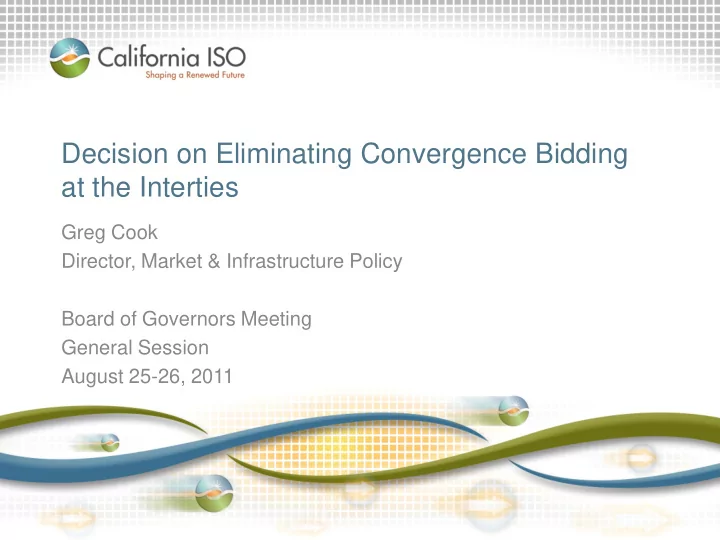

Decision on Eliminating Convergence Bidding at the Interties Greg Cook Director, Market & Infrastructure Policy Board of Governors Meeting General Session August 25-26, 2011
Convergence bidding implemented in February to provide market efficiency benefits. • Minimize differences between day-ahead and real-time prices – Lower costs due to more efficient day-ahead commitment – Improve grid operations • Mitigate supplier market power • Provide suppliers the ability to hedge against generator outages Page 2
Convergence bidding on the interties is not driving the intended market efficiencies. • The structure of the real-time market provides incentives for inefficient convergence bidding on interties. – Intertie convergence bids cleared at hour ahead scheduling process prices – Internal convergence bids cleared at real-time dispatch prices – Hour ahead scheduling process prices systematically lower than day-ahead and real-time prices Results in incentives for virtual supply bids on the interties that diverge day-ahead and real-time prices and increase uplift costs. Page 3
Convergence bidding on the interties is undermining the market efficiency benefits of the convergence bidding design. 1. RT > DA, INTERNAL virtual demand is expected 1. RT > DA, INTERNAL virtual demand is expected 1. RT > DA, virtual demand is expected Off Peak - 10 day moving average 2. HASP < DA, INTERTIE virtual supply is expected 2. HASP < DA, INTERTIE virtual supply is expected Virtual R Supply Price R T 3. HASP < RTD, 1 and 2 balanced is profitable T D H D Virtual A A Demand Real Time Imbalance Energy Offset (Total) S $20 P $18 $16 Offset (Millions) $14 $12 DA: Day Ahead $10 RT: Real Time $8 HASP: Hour Ahead Scheduling Process $6 RTD: Real Time Dispatch $4 $2 $0 FEB MAR APR MAY JUN SC Balanced Virtual Residual Virtual All Others Page 4
Hour ahead scheduling process prices consistently lower than day-ahead and real-time prices. IFM HASP RTD $30.00 $25.00 $20.00 $15.00 $10.00 $5.00 $- Feb Mar Apr May Jun Jul Off Peak Average Price Page 5
There is high virtual demand at the internal nodes and high virtual supply at the interties. Virtual Supply Virtual Demand Off Peak 10 Day Moving Average Page 6
Several alternatives were considered to resolve stakeholder concerns with convergence bidding on the interties: Real-time imbalance energy offset • Prohibit balanced virtual positions • Settle imports and exports at real-time price • Align virtual bid liquidation and settlement • Settlement rule to return revenue from balanced positions Intertie price inconsistencies • Price the two intertie constraints • Pay as-bid • Pay as-bid or better Slide 7
Some stakeholders argue that convergence bidding on the interties provides market benefits. • Lower cost to import renewables by enabling transmission to be procured after hour ahead scheduling process – Strategy not being used – Day-ahead physical schedule provides the same benefit • Virtual supply on interties reduces day-ahead prices which benefits load serving entities • Hedging against outages of physical imports – This hedge seldom used – Hour ahead scheduling process prices have little price volatility risk Page 8
Stakeholders are sharply divided on the proposal. • Strong support from load serving entities • Strong opposition from marketers • Agreement that two settlement timeframes for real-time market must be resolved • Disagreement on whether convergence bidding should be removed while real-time market issues are resolved Slide 9
Management requests Board approval to remove convergence bidding from interties. • Convergence bidding on the interties should be eliminated until real-time market design issues are resolved • Limited benefits of convergence bidding on the interties exceeded by costs due to real-time market issues • Eliminates issue of prices inconsistent with bids on interties • Comprehensive market redesign stakeholder initiative underway to address ISO market issues Slide 10
Recommend
More recommend